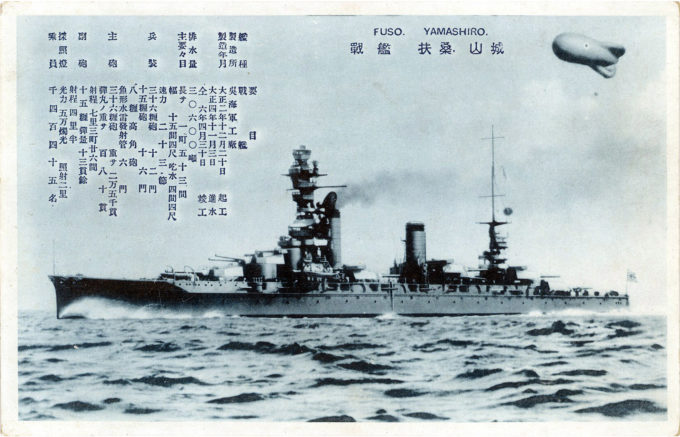
Nagato-class battleship Mutsu, c. 1925, was nearing completion in 1922 when, under the terms of the 1922 Washington Naval Treaty with Great Britain and the United States, it was to have been broken up or converted into an aircraft carrier but was rescued from its fate. Mutsu was assigned to the Main Body of the 1st Fleet during the Battle of Midway, its most prominent role during the Pacific War, but sunk in June 1943 after a magazine explosion broke the ship in two, and 1,121 sailors died, while moored at fleet anchorage at Hashirajima. No official acknowledgement of the sinking was made until after the end of the war.
See also:
Final Imperial Japanese Navy Fleet Review, 1940.
Imperial Japanese Navy training cruise, 1924-1925.
Imperial Japanese Navy battleship “Hyuga”, c. 1920.
Imperial Japanese Navy Battleship “Nagato”, c. 1925.
Imperial Japanese Navy aircraft carrier “Akagi”, c. 1930.
“The concept of the ‘Eight-Eight Fleet’ originated in the aftermath of the Russo-Japanese War with the 1907 Imperial Defense Policy. The policy called for the construction of a battle fleet of eight modern battleships of 20,000 tons each and eight modern armored cruisers of 18,000 tons each. These were to be complemented by the construction of several lesser warship types, including cruisers and destroyers. A further motivation to achieve the Eight-Eight Fleet ideal later resulted from an additional expansion of the U.S. Navy under President Woodrow Wilson’s 1919 plan to build another set of 16 capital ships (on top of the 16 already authorized in 1916).
“The first serious attempt to build an ‘Eight-Eight Fleet’ came in 1910, when the Naval General Staff proposed a building program of eight battleships and eight battlecruisers. The Navy Ministry cut back this request for political reasons, to seven battleships and three armored cruisers. The Cabinet eventually recommended just one battleship and four battlecruisers, and the Diet authorized these ships in 1911. The battlecruisers became the Kongō class and the battleship was Fusō: all were technologically advanced ships.
“The 1913 program saw a further three battleships authorized, making a total of ‘four-four’. These ships, Yamashiro, Ise and Hyūga, were sister ships or cousins of Fusō.
- Fuso-class battleship, c. 1925. authorized in the initial 1911 naval budget.
- Ise-class battleship, c. 1925, authorized in the 1913 naval budget.
“In 1915, the Navy proposed another four battleships, to reach an ‘Eight-Four Fleet’. This was rejected by the Diet. However, in 1916 the Diet agreed to an additional battleship and two battlecruisers. In 1917, in response to the U.S. Navy’s plan to build an additional ten battleships and six battlecruisers, the Diet authorized a further three battleships; and in 1918 the Cabinet authorized another two battlecruisers. In total, the authorization existed for an ‘Eight-Eight Fleet’.
“The new ships started were the two Nagato-class battleships, the two Tosa-class battleships, and a total of four Amagi-class battlecruisers: all modern, capable ships carrying 16-inch guns. Only the two Nagato-class ships were eventually completed in their intended role. One Tosa- and one Amagi-class were completed as aircraft carriers.
Akagi-class carrier & Kaidai-class submarine (I-51), c. 1925, authorized under the 1918 construction program. The Akagi was originally laid down as a Amagi-class battlcruiser. The I-51 was the prototype design for Japan’s first large, long-range (20,000+ nmi range) submarine.
“So great, though, was the difference in capability between this new generation of ships and those of just five years previously that the ‘Eight-Eight Fleet’ plan was restarted: Nagato was now regarded as Ship No. 1 in the new project, and planners now began to write off the older battleships and battlecruisers. On this revised basis the Navy was back down to a ‘Four-Four Fleet’.
“In 1920, a reluctant Diet was persuaded to accept a plan to bring the ‘Four-Four’ set of modern ships up to ‘Eight-Eight’ strength by 1927. This would have involved an additional four ‘fast’ battleships, marginally slower than the Nagato-class and but more powerful, and a further four battleships built with 18-inch guns (significantly larger than the contemporary American North Carolina- or British Nelson-class battleships). If completed, this would have been an ‘Eight-Eight Fleet’ in full.
- Kongo-class battlecruiser, c. 1925, authorized in the 1911 naval budget.
- Furutaka-class heavy cruiser, c. 1925.
- Sendai-class light cruiser, c. 1925.
- Kuma-class light cruiser, c. 1925.
“The Washington Naval Treaty of 1922 put an end to these construction plans. Under the terms of the treaty all the ships still being built — which meant all ships started after Nagato, the first ship of the 1916 building program — had to be broken up or converted into aircraft carriers. A special exemption was made for the battleship Mutsu, which was nearing completion and which had a special place in many Japanese hearts, with many of the funds for her construction raised by public subscription.”
– Wikipedia








